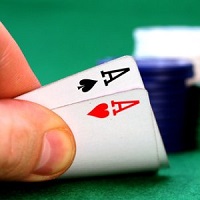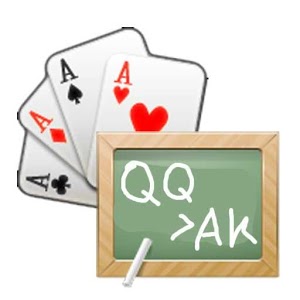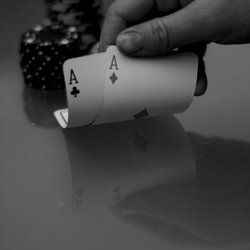In the previous article, we discussed how winners play to scoop the pot. Winners always keep an eye out on how well their cards are coordinated. Most of their edge comes from playing better preflop than their opponents would with their cards. In this article, we are looking at how to apply these general principles in selecting and playing specific starting hands. What should you look for when you are dealt a hand?
Look-for #1: Key Card
Certain cards are more important than others. Ace is the key card in Omaha high/low. It is a perfect scooping card in that it is the best high and low card. Here I will iterate an advice given by most other poker authors: as a beginner, you would not be losing much if you did not play any hands that do not have an ace in them. There are certain strong hands that do not have an ace in them (such as KK23 or KKJQ double-suited for example), but most of them are hard to play for a beginner. Stick with an ace when you’re starting out. You’ll be happier when you count your chips. In a ten-handed Omaha game, 40 cards are dealt out preflop. That’s close to 80% of the deck. This means that on average, there will be about three aces out preflop. If you do not have an ace, you are not only missing a key scoop card in your hand, but you are also increasing the chance that somebody else has it instead of you.
Look-for #2: Low Possibilities
You will not become rich playing hands that can win either high or low. You should play scooping hands. In this particular section, we are looking at how to evaluate the low possibility only. Always keep in mind there is not always a low hand, but there is always a high hand.
What is the best two-card low combination to have in your hand? Clearly, A2. Many poker authors will tell you to play A2XX in any position under any circumstances. But this is simply wrong. A2XX is the most over-valued hand in Omaha high/low.
Suppose you are on the button. If a player raises in early position, two players call in middle position, and the fourth player in late position re-raises, your A2 with nothing else is simply not a hand that has a positive expectation. You are likely up against another A2, if not A23X or A2 with two other low cards, as well as hands with good high possibilities. This is a break-even situation for you at best. You should fold your A2XX without any hesitation.
Consider that the players in question hold the following hands:
| Player | Hand | Relative EV |
| #1 | Js 2c Ad Td | 0.207 |
| #2 | As Qs 4s 3s | 0.210 |
| #3 | 5s Qc Jh 3h | 0.188 |
| #4 | Kc 6c Kd 8d | 0.219 |
| You | 9c 7d 2d Ah | 0.177 |
Notice that your hand has the lowest EV, even lower than player #3’s junky hand. Many players entering the pot usually means that there are multiple low draws, with most aces out. Therefore A2XX, while a nut low drawing hand, is not always a playable hand.
Recall from a previous article that you want your cards co-ordinated as much as possible. With respect to low possibilities, this means having extra low cards that protect your hand against counterfeits. A23X and A24X both have excellent backups. Suppose you play A23X and the flop comes 27J. Your 2 is now counterfeited, but you still have a nut low draw using A3 as your low cards.
But what about hands such A3XX, A4XX, A5XX, A6XX…etc. as low possibilities?
Consider A6XX, A7XX, and A8XX to be junk. Don’t play them, they are very weak. You can’t make the nut low and will have to go against better lows nearly every time.
A5XX without other low cards (i.e. 2,3, or 4) is very marginal as a low hand. You will need exactly 2, 3, and 4 to make the nut low. If you don’t catch two of these on the flop, you will likely not be in a position to continue. Even if you do catch, your hand is not that great with nothing else going for it.
A4XX is a classical steamer’s hand. While slightly better than A5XX, it is still not playable unless you have other (good) low cards or high possibilities. Never play it for low alone in a full ring game out of position with somebody already in the pot.
A3XX is a good low hand but often overplayed. It is not an automatic call as many players think. In a well attended pot, you might easily be beat or quartered. Consider a flop of 58K. If there is lot of jamming in front of you, you are very likely drawing to a second best low.
In thinking about these hands, you should also consider the following factors:
- Counterfeit on later rounds – for example, with a hand A2JJ and the board 36QT2, your low is counterfeited on the river.
- No low cards on turn/river – same hand, with the board 36QQK.
- Quartered pot – same hand, with the board 36QQ8, but another player holding A2XX.
For beginners, it is probably best to expect the worst with a low draw. Don’t jam the pot early unless you have a premium draw with counterfeit protection. Nearly all low limit players will enter the pot with A2XX, and most will play dry A3XX in any position. You need to be smart when considering your low draw. Do you have high possibilities to go with it? Do you have counterfeit protection? Does it look like another player is drawing to the same nut low? Omaha high/low is not a mindless game, but requires careful reflection in order to play your hand in the best way.
Look-for #3: High Possibilities
What is the best hand with high possibilities? If you said AhAdAcAs, you should probably stick to play money for now (remember, use only two!). The best hand would clearly have powerful two-card combinations that allow you to make nut boats, flushes, and straights. Double suited aces with kings (such as AcKcAsKs) have many possibilities. You have top two pairs, two nut flush possibilities, and a straight possibility. Of course, double suited wrap-around straights are also good (such as ThJsQhKs). Again, co-ordination is very important (recall that “just” one un-coordinated card cuts your possibilities in half!).
There are other considerations as well. There is always a high hand, but not always a low hand. The board can make it impossible to make a low hand. Just as you have to use two cards from your hand, you must use three cards from the board. The boards of A22JQ or KJ25J do not have three distinct low cards, and therefore there cannot be low hands made. In other words, the high hand will scoop (or split with another high, in some cases). Most advice for beginning Omaha high/low players revolves around “playing to scoop”. Some players do not realize that this necessarily does not involve winning high and low. If there is no low, then scooping merely means winning the high. Clearly, this is a position in which you want to be with your high hands.
Consider a situation in which you hold Th Jd Qh Kd in late position. There are two limpers in front of you. You decide to call. Button, small blind, and big blind all call. Six players see the flop of 6h Td 7h.
What do you have?
“I have a draw to…. and a ….”
There is a more important question you should be asking yourself first. How does my high hand stand with respect to scooping? In other words:
1) is there a strong low draw out there that will likely force a split pot?
2) If there is no low draw out there, how does my high stand?
The flop is bad news for you. 6 and 7 indicate that a low will likely be made. There are 45 (yet) unseen cards in the deck. Any ace, 2, 3, 4, 5, or 8 will allow a low to be made (notice that there is more low cards in the deck than high cards). That’s 24 cards (6 times 4). Minimally, if we discount two aces and say, four low cards (due to five other players seeing the flop, most of whom usually play with an ace and some low card), we have 18 cards. So that’s 18 out of 45 cards that can come on either turn or river that will likely split pot. The chance of making low by the river is about 65% (i.e. 1 – (27/45 * 26/44)). It is likely that this will be a split pot. To make matters worse, your high is not that great. Your pair is very weak. You need to catch a heart to make a flush. If you catch runner-runner Ah and Kh, you’ll have nut high (but note that now a low will be possible, due to Ah). You will likely make only a third-best or a second best flush. How many outs do you have? Subtracting Th and Qh (in your hand) and 6h and 7h (on the board), we have 9 hearts. But wait! We have to make sure that we take into account situations in which the board might pair. Often players will flop a set and take it all the way hoping to make a boat or to win without improving. Th might make somebody’s full house, if not quads. Therefore you have 8 hearts. If the turn is not a heart and does not pair the board, we have only 7 hearts left (discount another heart because of another possible pairing on the river). So really, you are drawing to half the pot, to second or third best high, with only 8 outs at best. You would need good pot odds to make a call. You will simply not get them in this situation. Some players might fold, others might raise cutting your pot odds further. This is clearly folding hand. Your high is junk and will do poorly while there are strong low possibilities on the board.
Omaha high/low players often disagree as to how high hands should be played. Should I raise pre-flop, or keep players in? Get in cheap or make it expensive for low draws? Perhaps the key is to understand the ratio of low to high cards in the deck. Out of 52 cards, 32 are low and 20 are high only. On average, one can expect to see about 60% low cards on the flop. In other words, the flop will usually not favour high-only hands. But when it does, you will usually have a strong hand. When it does not, you will have to fold. Therefore you do not want to put in lot of money preflop with high only hands. Of course, there are exceptions. Good high hands do well heads-up or short-handed. You may also consider a steal in late position if no players entered the pot or if the situation is favourable in some other ways.
These three look-fors should give you a solid sense of direction when you evaluate your hand. You should never play a hand because you “feel like it”. Make sure you have good reasons. Analyze it in terms of the factors discussed. At most lower limit tables, you will be ahead of your average competition.
Submit your review | |











